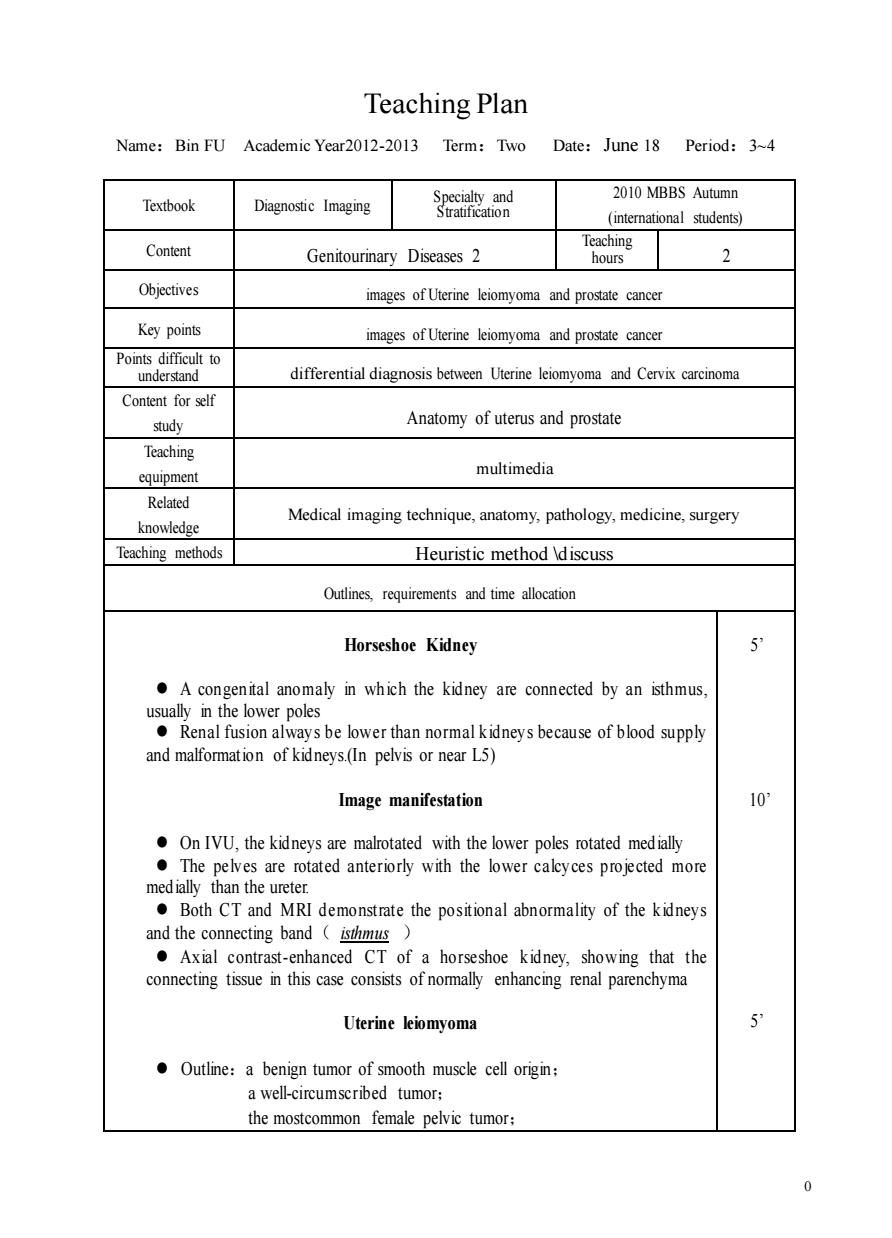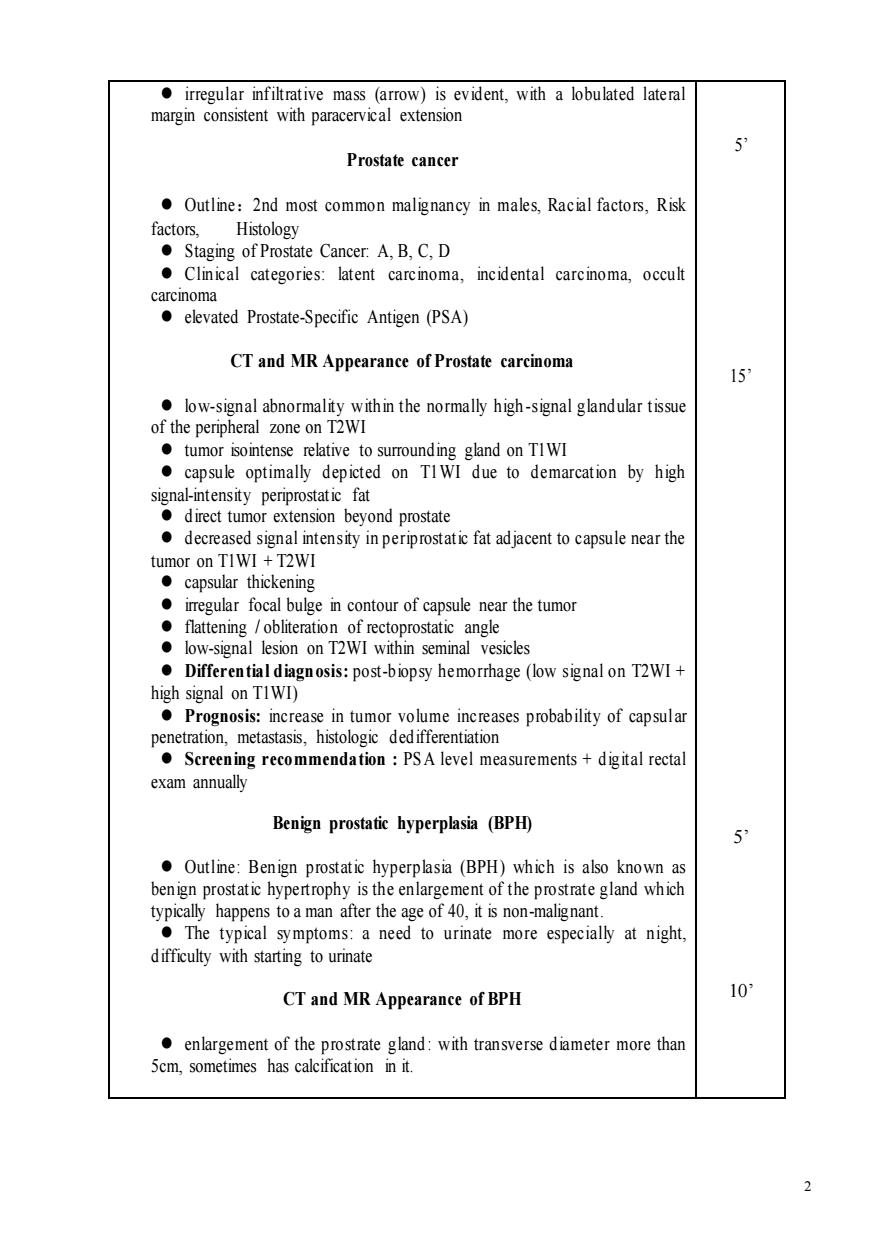
Teaching Plan Name:Bin FU Academic Year2012-2013 Term:Two Date:June 18 Period:3~4 Textbook Diagnostic Imaging 2010 MBBS Autumn (intemational students) Content Teaching Genitourinary Diseases 2 hours 2 Objectives images of Uterine leiomyoma and prostate cancer Key points images of Uterine leiomyoma and prostate cancer Points difficult to understand differential diagnosis between Uterine leiomyoma and Cervix carcinoma Content for self study Anatomy of uterus and prostate Teaching multimedia Related knowledge Medical imaging technique,anatomy,pathology,medicine,surgery Teaching methods Heuristic method discuss tinesrequrements and time alltion Horseshoe Kidney A congenital anomaly in which the kidney are connected by an isthmus usually in the oles ●Renal fusi of kidneys(In pelvis or near L5) Image manifestation 10 OnIVU,the kidneys are malrotated with the lower poles rotated medially The pelves are rotated anteriorly with the lower calcyces projected more medially than the ureter. Both CT and MRI demonstrate the positional abnormality of the kidneys and the connecting band isthmus ·Axial comrast-enhanced CT,showing that the connecting tissue in this case consists of normally enhancing renal parenchyma Uterine liomyoma Outline:a benign tumor of smooth muscle cell origin: a well-circumscribed tumor: the mostcommon female pelvic tumor: 0
0 Teaching Plan Name:Bin FU Academic Year2012-2013 Term:Two Date:June 18 Period:3~4 Textbook Diagnostic Imaging Specialty and Stratification 2010 MBBS Autumn (international students) Content Genitourinary Diseases 2 Teaching hours 2 Objectives images of Uterine leiomyoma and prostate cancer Key points images of Uterine leiomyoma and prostate cancer Points difficult to understand differential diagnosis between Uterine leiomyoma and Cervix carcinoma Content for self study Anatomy of uterus and prostate Teaching equipment multimedia Related knowledge Medical imaging technique, anatomy, pathology, medicine, surgery Teaching methods Heuristic method \discuss Outlines, requirements and time allocation Horseshoe Kidney ⚫ A congenital anomaly in wh ich the kidney are connected by an isthmus, usually in the lower poles ⚫ Renal fusion always be lower than normal kidneys because of blood supply and malformation of kidneys.(In pelvis or near L5) Image manifestation ⚫ On IVU, the kidneys are malrotated with the lower poles rotated medially ⚫ The pelves are rotated anteriorly with the lower calcyces projected more medially than the ureter. ⚫ Both CT and MRI demonstrate the positional abnormality of the kidneys and the connecting band( isthmus ) ⚫ Axial contrast-enhanced CT of a horseshoe kidney, showing that the connecting tissue in this case consists of normally enhancing renal parenchyma Uterine leiomyoma ⚫ Outline:a benign tumor of smooth muscle cell origin; a well-circumscribed tumor; the mostcommon female pelvic tumor; 5’ 10’ 5’

single or multiple: Classification:submucosal,intramural (or interstitial),subserosal Symptoms:pelvi pain,dysmenomhoea,infertility Imaging Diagnosis to. CT features:a focal solid mass causing lobulation or protrusion from the outer margin of the terus,cavity Focal califications and irregular low-density areas in the ofmr or1 signal intensity and homogeneously low T2 signal intensity,relative to the adjacent myometrium Slight slow diffuse homogeneous enhancement may occur after intravenous gadolinium chelates Treatment:hysteroscopy,myomectomy Cervix carcinoma S Outline:Risk factors for the development of cervical carcinoma include early age at first intercourse,multiple sexual partners,and low socioeconomic status Symptoms:two major symptoms of cervical carcinoma are vaginal bleeding and discharge Approximately 90%of cervical malignancies are squamous cell arcinomas The carcinomas occur at the Imaging Diagnosis 6 ●CT features to demonstrate the primary tumor,as well as other important sta reliable of these signs is obliteration of the periureteric fat plane,usually a late finding with gross parametrial invasion Detecte pelvic side wall invasion Gross invasion of the bladder or rectum is usually seen as loss of fat planes and irregular wall thickening MRI features Cervical carcinoma is identified as a high signal intensity mass on T2W This is in stark contrast to the low signal of nommal cervical stroma
1 single or multiple; ⚫ Classification:submucosal, intramural (or interstitial),subserosal ⚫ Symptoms:pelvic pain,dysmenorrhoea,infertility Imaging Diagnosis ⚫ CT features: a focal solid mass causing lobulation or protrusion from the outer margin of the uterus, or distorting or obliterating the uterine cavity Focal calcifications and irregular low -density areas in the mass are also suggestive ⚫ MRI features: well-circumscribed masses of similar or slightly low T1 signal intensity and homogeneously low T2 signal intensity, relative to the adjacent myometrium Slight slow diffuse homogeneous enhancement may occur after intravenous gadolinium chelates ⚫ Treatment:hysteroscopy,myomectomy Cervix carcinoma ⚫ Outline:Risk factors for the development of cervical carcinoma include early age at first intercourse, multiple sexual partners, and low socioeconomic status ⚫ Symptoms:two major symptoms of cervical carcinoma are vaginal bleeding and discharge ⚫ Approximately 90% of cervical malignancies are squamous cell carcinomas ⚫ The majority of cervical carcinomas occur at the squamocolumnar junction Imaging Diagnosis ⚫ CT features: to demonstrate the primary tumor, as well as other important sta reliable of these signs is obliteration of the periureteric fat plane, usually a late finding with gross parametrial invasion ⚫ Detecte pelvic side wall invasion ⚫ Gross invasion of the bladder or rectum is usually seen as loss of fat planes and irregular wall thickening MRI features ⚫ Cervical carcinoma is identified as a high signal intensity mass on T2WI ⚫ This is in stark contrast to the low signal of normal cervical stroma 10’ 10’ 15’ 5’

irregular infiltrative mass (arrow)is evident,with a lobulated lateral margin consistent with paracervical extension Prostate cancer Outline:2nd most common malignancy in males,Racial factors,Risk factors, Histology Staging of Prostate Cancer.A,B,C.D Clinical categories:latent carcinoma,incidental carcinoma,occult carcinoma elevated Prostate-Specific Antigen(PSA) CT and MR Appearance of Prostate carcinoma 15 low-signal abnormality within the normally high-signal glandular tissue of the peripheral zone on T2WI tumor isointense relative to surrounding gland on TIWI capsule optimally depicted on TIWI due to demarcation by high signal-intensity periprostatic fat direct tumor extension bev ond prostate decreased signal intensity in periposta fat adjacent tocapsule near the rIWI+T2WI capsula ning irregular focal bulge in contour of capsule near the tumor flattening /obliteration of rectoprostatic angle low-signal lesion on T2WI within seminal vesicles Differential diagnosis:post-biopsy hemorrhage (low signal on T2WI+ high signal on TIWI) Prognosis:increase in tumor volume increases probability of capsula penetration,metastasis, Scre enin :PSA level measurements+digital rectal exam annually Benign prostatic hyperplasia (BPH) 5 Outline:Benign prostatic hyperplasia(BPH)which is also known as benign prostatic hypertrophy is the enlargement of the prostrate gland which typically happens to a man after the age of 40,it is non-malignant. The typical symptoms:a need to urinate more especially at night difficulty with starting to urinate CT and MR Appearance of BPH 10 2
2 ⚫ irregular infiltrative mass (arrow) is evident, with a lobulated lateral margin consistent with paracervical extension Prostate cancer ⚫ Outline:2nd most common malignancy in males, Racial factors, Risk factors, Histology ⚫ Staging of Prostate Cancer: A, B, C, D ⚫ Clinical categories: latent carcinoma, incidental carcinoma, occult carcinoma ⚫ elevated Prostate-Specific Antigen (PSA) CT and MR Appearance of Prostate carcinoma ⚫ low-signal abnormality within the normally high -signal glandular tissue of the peripheral zone on T2WI ⚫ tumor isointense relative to surrounding gland on T1WI ⚫ capsule optimally depicted on T1WI due to demarcation by high signal-intensity periprostatic fat ⚫ direct tumor extension beyond prostate ⚫ decreased signal intensity in periprostatic fat adjacent to capsule near the tumor on T1WI + T2WI ⚫ capsular thickening ⚫ irregular focal bulge in contour of capsule near the tumor ⚫ flattening / obliteration of rectoprostatic angle ⚫ low-signal lesion on T2WI within seminal vesicles ⚫ Differential diagnosis: post-biopsy hemorrhage (low signal on T2WI + high signal on T1WI) ⚫ Prognosis: increase in tumor volume increases probability of capsular penetration, metastasis, histologic dedifferentiation ⚫ Screening recommendation : PSA level measurements + digital rectal exam annually Benign prostatic hyperplasia (BPH) ⚫ Outline: Benign prostatic hyperplasia (BPH) which is also known as benign prostatic hypertrophy is the enlargement of the prostrate gland which typically happens to a man after the age of 40, it is non-malignant. ⚫ The typical symptoms: a need to urinate more especially at night, difficulty with starting to urinate CT and MR Appearance of BPH ⚫ enlargement of the prostrate gland : with transverse diameter more than 5cm, sometimes has calcification in it. 5’ 15’ 5’ 10’

Symmetry enlargement. Homogeneous low signal intensity on TIWI. The peripheral zone has normal signal intensity on T2WI-high signal intensity. Contrast-enhanced images,the prostate gland enhances homogeneously. 3
3 ⚫Symmetry enlargement. ⚫Homogeneous low signal intensity on T1WI. ⚫The peripheral zone has normal signal intensity on T2WI—high signal intensity. ⚫Contrast-enhanced images, the prostate gland enhances homogeneously